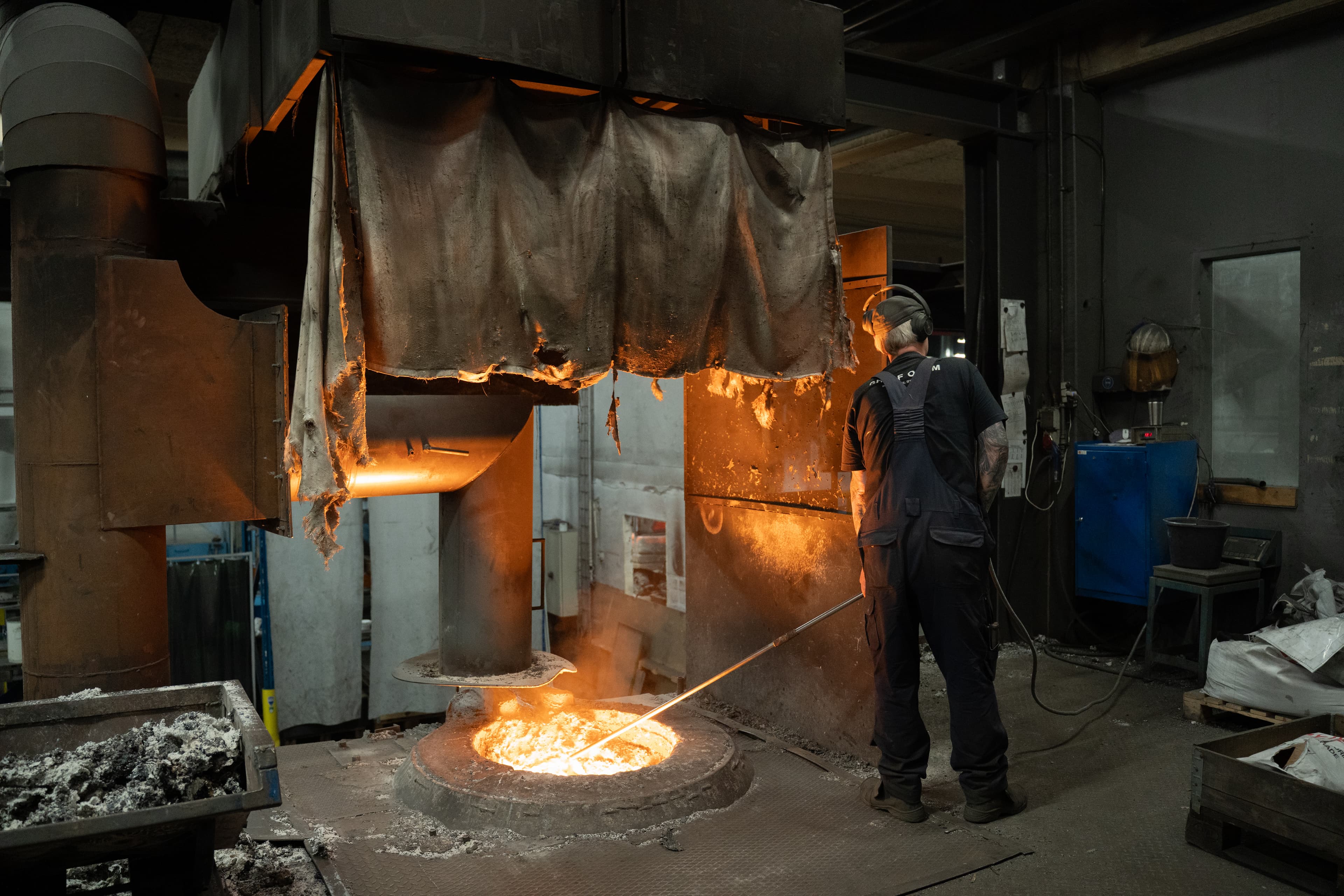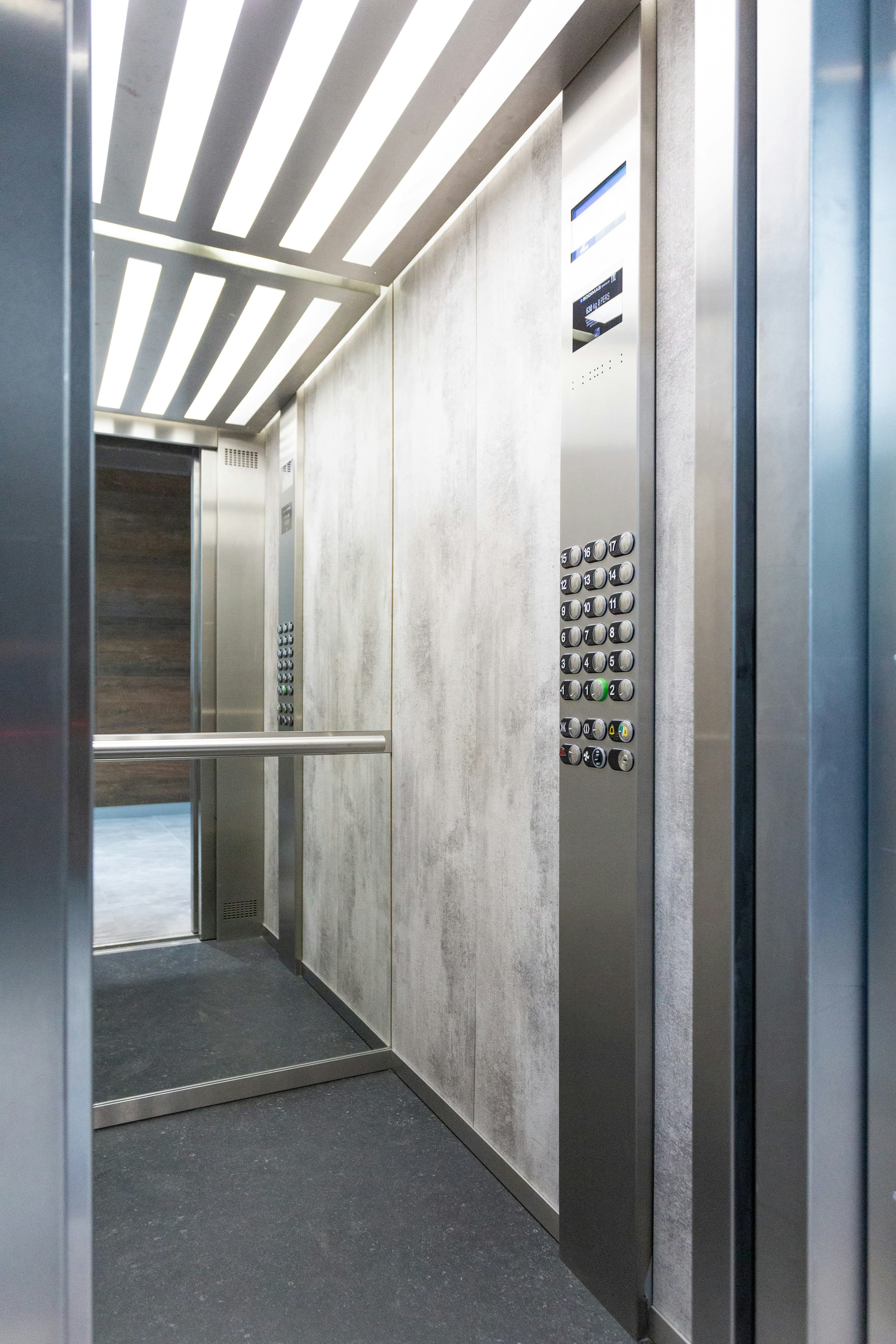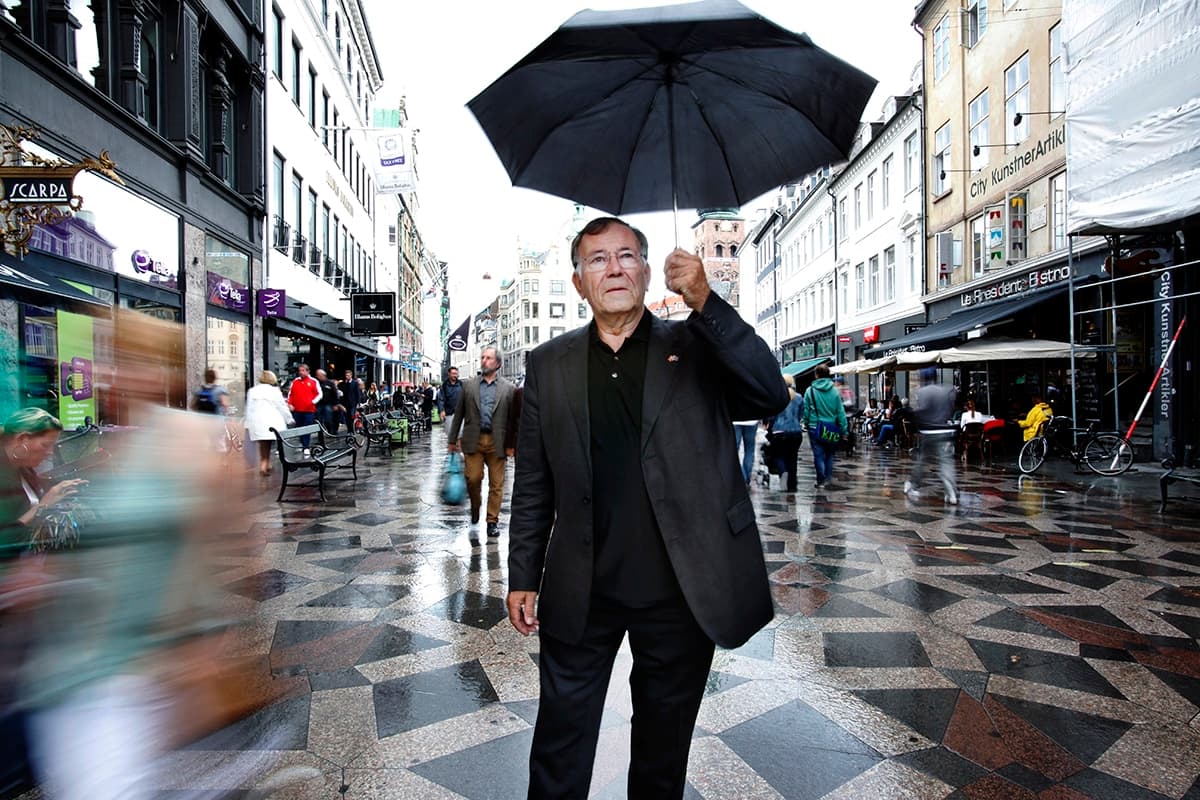Can Good Design Break the Awkward Silence in Elevators?
In many ways, the elevator is a magical space. One push of a button and you arrive somewhere new in just seconds. And yet, it’s also one of the most overlooked spaces in our everyday lives – a place that could use a little design love to break the awkward silence and sterile surfaces.
By Anna Skovby Hansen
The doors slide open to a steel cabin with mirrors from floor to ceiling. You step inside, sniffle a little, press 4, and flash a crooked smile at your fellow passenger who presses 6. And there you stand.
There are no escape routes, and the bubble of personal space has already been breached in the tiny room. Even though the ride is short, it can feel like time stands still – because what exactly are you supposed to say? And should you say anything at all?
Mette Gravergaard, Head of Space Planning and Interior Design at Sweco, calls the elevator a magical space. It’s a place where the ride itself can be an experience. But she also believes it’s a space that is often overlooked when design priorities are set.
Mette Gravergaard, chef for Space Planning og Indretning i Sweco, kalder elevatoren et magisk rum. Det er nemlig et sted, hvor selve turen kan være en oplevelse i sig selv. Men hun mener også, at det er et rum, der ofte bliver overset, når der skal prioriteres i designprocessen.
»As designers and architects, we need to think more about how to activate the space, and we should push building owners a bit harder so resources are actually allocated to it. The elevator is an important space, but it’s one that lacks love,« says Mette Gravergaard.
"It’s steel, glass, and a bit boring. There aren’t many expectations when it comes to elevator design."
Different Social Rules Apply
According to Signe Bonnén, a conversation and communication consultant, the elevator comes with a lot of relational tension.
»First of all, it’s a small, enclosed space where personal boundaries are often crossed. And when you know you’re only going to be in there for a very short time, it can make the situation even more awkward,« she explains.
Social norms and expectations also vary depending on where we are.
»In a department store or a public elevator, a nod or a small smile is more than enough interaction – without it feeling awkward. We don’t expect much there. But at work it’s different. We have relationships with one another, and we don’t want to seem dismissive, but we also don’t want to start a conversation that will last all of ten seconds,« says Signe Bonnén.
Elevators are, in many ways, the perfect place for small talk, yet many Danes famously find it difficult or uncomfortable to initiate a conversation.
A 2019 Megafon survey actually showed that eight out of ten Danes would rather do something else than talk to strangers in public spaces.
We know the dynamic from public transportation, where a packed train car can still be completely silent during rush hour.
»If you step into an elevator with a good colleague, you expect to chat – because it’s part of the social contract. If we don’t, we might subconsciously wonder whether we’re breaking that contract, and suddenly the silence feels awkward,« explains Signe Bonnén.
This is why the ‘quick topics’ tend to surface – small-talk topics – because small talk isn’t about the topic being interesting. It’s about acknowledging each other’s presence.
The Social Elevator Ride Can Actually Make Us Happier
It can actually pay off to make conversation in the elevator, even if it’s just, »What a day, huh?”«
Many people assume that talking to strangers in public makes us less happy. But when we actually do it – and have a positive experience – we end up feeling more connected and more cheerful.
A study from Sabanci University in Turkey and the University of Sussex in England found that people who had both short and longer interactions with strangers reported higher life satisfaction and more happiness compared with those who kept to themselves.
Happiness research shows that avoiding small talk doesn’t make us happier – yet we avoid it anyway.
Mette Gravergaard sees the elevator as a vertical link in architecture – a space that invites both meeting and pause.
»For me, the elevator can be awkward because you’re standing close together, and some people want to talk while others would rather stay quiet. But it can also be a lovely moment in the morning where you catch up with a colleague or greet someone you don’t know well. And sometimes the ride is simply a small break,« she says.
She also points out the potential of integrating art and architecture more intentionally into elevator design – very concretely, by creating artworks in the elevator itself.
3 Elevator Facts
1. The First Elevator
1. The modern elevator was developed by Elisha Otis in the 1850s when he invented a passenger elevator with a safety brake that prevented free-fall. The invention made it possible to move quickly and safely between many floors and became a turning point in urban development.
2. Building Upward
The elevator changed architecture forever, paving the way for high-rises and skyscrapers – building types that would otherwise be practically useless. Few people are willing or able to climb more than five flights of stairs.
3. More Inclusive Cities
Today, the elevator is a basic requirement in Danish construction. It makes cities more accessible and inclusive for everyone. According to the building code, new buildings with three floors or more must have at least one elevator that serves all floors.
Small Talk Over Big Talk
According to communication consultant Signe Bonnén, the elevator is all about balancing time and conversation.
»You only have a few seconds together – it’s not the moment for a big talk. So you lean on the small talk,« she says.
The question “How are you?” is too big for an elevator ride. Instead, it becomes: “Some rain today,” or “Busy as well?” – simple little lines that keep silence at bay, because for some people, the elevator ride can otherwise feel like mild torture.
Bonnén suggests that design can help ease the conversation.
»You could hang up pictures that give people something to comment on, or play music that sets the mood, or post the cafeteria’s weekly menu. Small touches that make the elevator more human,« she suggests.
So, in addition to connecting floors, the elevator might also connect people.
The Elevator as a Clinical, Sterile Space
According to Ryan Hald, director and partner at Minelevator, Denmark doesn’t really have the same elevator culture as many other countries.
»In Sweden, almost every building has an elevator – including older ones. And if you think back to a trip to Southern Europe, you may remember the tiny elevators running up and down the center of stairwells,« he explains.
In Denmark, elevator interiors often evoke hospitals, Hald points out.
»It’s steel, glass, and kind of boring. Expectations for elevator design aren’t very high,« he says.
»Inside the shaft, there are all kinds of rules – there must be rescue space above and below the cabin so the technician doesn’t get crushed. There are lots of regulations around motors and controls. But inside the cabin itself, the requirements mostly involve a mirror, a handrail, and where the buttons should be placed,« he explains.
There are, however, older Danish examples where elevators were designed to match the building’s architecture.
»The Danish tradition actually includes beautiful elevators made of wrought iron and wooden slats,« says Mette Gravergaard, Head of Space Planning & Interior Design at Sweco.
»Especially back when building owners also owned their properties and wanted to show quality. Today, many people rent space in modern buildings, and so the details often get deprioritized.«
7 Incredible Elevators Around the World
One World Trade Center, New York
On your way to the 102nd floor, the elevator doesn’t just take you up – it takes you back in time. A 3D animated panorama shows Manhattan’s evolution from the 1600s to today.
Bailong Elevator, China
In Zhangjiajie’s dramatic landscape, the Bailong Elevator lifts passengers 326 meters up a vertical cliff in just two minutes. The double-deck glass elevator offers unobstructed views of floating sandstone pillars.
Santa Justa Elevator, Lisbon
In the middle of Lisbon stands this Gothic-inspired iron tower. Two elegant elevator cars lift passengers 32 meters from Baixa to the lively Bairro Alto.
Hammetschwand Elevator, Switzerland
By Lake Lucerne, you ascend 152 meters vertically up the mountainside in under a minute. Since 1905, this iconic steel elevator has provided visitors with the ultimate panoramic ride.
Louvre Elevator, Paris
In the heart of the Louvre, a round glass elevator rises from the floor like a piece of living architecture. With no visible walls or cabin, it feels like you’re floating through the museum’s atrium.
Burj Khalifa, Dubai
Here, the world’s tallest building soars 828 meters high, and the elevator carries you through its countless levels with sweeping views of the entire city.
Guangzhou, Kina
This super-elevator rockets you to the 95th floor in just 43 seconds, reaching a speed of 72 kilometers per hour.
Elevators Need More Love
It can almost feel comical to enter a meticulously designed building – top to bottom – only to end up in a standardized stainless-steel elevator that looks untouched by any designer. We rarely spend much money on elevators, and as a result, they often end up sterile and utilitarian, Mette Gravergaard emphasizes.
»As an architect, I would love to see more inside-out thinking – giving this space more love as well. The richness of detail we once had should make a comeback,« she says.
Historically, we have examples of beautiful elevators where materials and craftsmanship matched the building’s overall expression, Mette Gravergaard explains.
»Just look at the elevator in Galeries Lafayette in Paris. Or newer projects show it’s still possible – like the Kilen building at CBS, where the elevator is designed as a round glass tube,« describes Mette Gravergaard.
»The meeting of art and architecture is always powerful. If we could bring artistic elements into the elevator, it could spark conversation – and maybe even a little life between floors,« she says.
When the elevator receives design attention, it also creates better conditions for conversation that doesn’t feel uncomfortable.
»We need to get better at having inclusive conversations so everyone can contribute. Those small everyday exchanges matter, because they’re what connect us,« concludes Signe Bonnén.
She suggests that elements like changing music or rotating artworks could soften the space and serve as conversation starters. For example, if new images were swapped in every month, there would always be something fresh to talk about. It could even become a shared responsibility or a space for book, film, and podcast recommendations.






